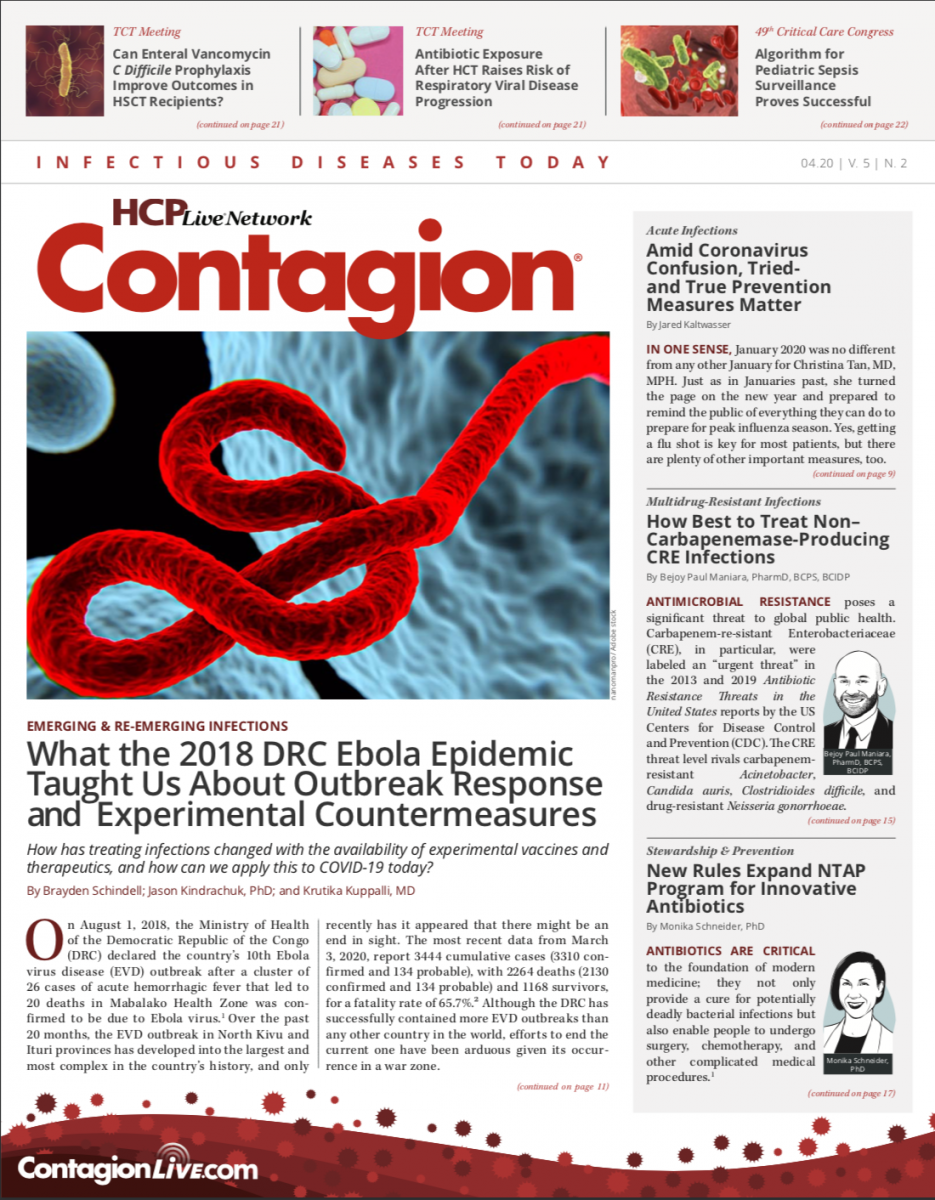Ending the HIV Epidemic Initiative: A Snapshot From the Trenches, 1 Year Later
Funded jurisdictions scramble to meet daunting deadlines yet maintain optimism that the new federal initiative can end flat funding and catalyze progress.
In March 2018, US Centers for Disease Control and Prevention (CDC) Director Robert Redfield, MD, said the United States could end its HIV epidemic “in 3 to 7 years if we put our minds to it,” and the 2019 State of the Union address promised to end the epidemic by 2030.1,2 Subsequently, the US Department of Health and Human Services (HHS) announced Ending the HIV Epidemic (EHE): A Plan for America, an initiative that built on the Obama administration’s groundbreaking 2010 and 2015 National HIV/AIDS Strategy.3,4 The plan’s 4 pillars—diagnose, treat, prevent, and respond (to outbreaks)—aim to reduce new HIV diagnoses by 75% in 2025 and 90% in 2030.5 Its initial phase includes 48 jurisdictions; Washington, DC; and San Juan, Puerto Rico, which account for over half of new diagnoses annually, as well as 7 states with predominantly rural epidemics. The 2020 budget includes $291 million for EHE.6
The CDC and the Health Resources Services Administration (HRSA) released multiple EHE funding opportunities (Table 1)7-15 and awarded 2019 funds for jump-start pilot proj­ects and jurisdictional planning. The Indian Health Service funded 1 jump-start site in Oklahoma’s Cherokee Nation, and the National Institutes of Health and National Institute of Mental Health awarded implementation science research pilot grants through their Centers for AIDS Research and AIDS Research Centers, respectively.8,10 HRSA awarded implementa­tion funds for the Ryan White HIV/AIDS Program in March, with CDC funding to follow in June. One year after the EHE announcement, a snapshot across 6 geographic areas—metro Atlanta, Georgia; Baltimore, Maryland; East Baton Rouge Parish, Louisiana; New York, New York; San Antonio, Texas; and San Francisco, California—found a torrent of energy directed toward planning, submission of funding applications, and early pilot activity.
INITIATION OF JUMP-START PILOT PROJECTS
The CDC and IHS announced in June 2019 that Baltimore; DeKalb County, Georgia; East Baton Rouge; and the Cherokee Nation would each receive $1.5 million to implement jump-start projects by December 31 (Table 2 online).7,8 CDC recip­ients had about 3 weeks to submit proposals. Baltimore rapidly engaged community partners to create 14 new programs. Community engagement is “a cross-cutting pillar” of Baltimore’s work. Innovative activities include expanding the reach of Johns Hopkins Medicine’s I Want The Kit website and adding HIV self-test kits to the sexually transmitted infection (STI) kits already available online, adding an HIV expert “warm line” for clinicians, creating a tool to allow clinicians to view patient panels stratified by viral load suppression, and offering enhanced case management services.16 Prevention programs include a social network strategy for pre-exposure prophylaxis (PrEP) recruitment. A hybrid disease intervention specialist/community health worker model to enhance care engagement will use Ryan White EHE funds.
DeKalb County experienced challenges with contract execu­tion and hiring, requiring an extension until June 2020. In November, it opened a sexual health clinic to provide HIV/STI screening and PrEP initiation in partnership with Rollins School of Public Health at Emory University in Atlanta. DeKalb also is expanding PrEP to an existing county clinic and 3 community organizations. HIV testing will expand through community organizations, a jail, an emergency department (ED), and a federally qualified health center (FQHC).
East Baton Rouge expanded HIV testing capacity through 5 community partners and 2 EDs, as well as enhanced HIV, syph­ilis, and hepatitis C population-level screening in prisons. The parish extended its health model patient incentive program to a new FQHC partner, employed a “rapid start” navigator to expedite linkage and treatment for individuals with new diagnoses, added a TelePrEP navigator, expanded syringe services program (SSP) capacity, and hired community health workers to link hot spot communities with basic resources and HIV testing.
The Cherokee Nation is expanding routine HIV screening, especially in clinical settings; increasing access to PrEP; advo­cating for SSPs; and aiming to reduce stigma. Omission from the 2020 federal budget, however, threatened sustainability, although funds now have been included in the proposed 2021 budget.
EHE PLANNING: ATTACKING INEQUITIES, DISPARITIES, AND STIGMA
San Francisco’s Getting to Zero consortium and New York City’s End the Epidemic blueprint led to substantial progress in controlling their epidemics, even before the federal EHE initia­tive.17,18 Both, however, have persistent new diagnoses concen­trated in underserved populations.
As part of EHE, San Francisco will target health dispari­ties and inequities that drive its remaining 197 annual new diagnoses, according to Diane Havlir, MD, cochair of Getting to Zero’s steering committee and HIV/AIDS division chief at University of California, San Francisco. She said that a “rapid strategic-planning process” employs a racial and social justice lens to address housing, mental health, substance use, incar­ceration, and stigma while integrating HIV, STI, and hepatitis C prevention and treatment. Creating low-threshold, neigh­borhood-based services for priority populations and collab­orating with Alameda County (Oakland) in the East Bay are important elements of the city's strategy.
New York City’s EHE plan identifies overarch-ing priorities of advancing equity and eliminating stigma and aims to confront “structural racism and other systems of oppression” that fuel the epidemic.19 The plan addresses stigma, the HIV/STI syndemic, and the impact of social determinants of health. Funds support community engagement activities, including listening sessions in the 4 funded boroughs and among priority populations. Strategies include supporting priority populations directly through grassroots organizations.
THE SOUTH: EHE WITHOUT A SAFETY NET
Barbara Taylor, MD, cochair of the End Stigma End HIV Alliance, describes San Antonio’s safety net as “fragile” without Medicaid expansion and acknowledges that EHE requires tackling “giant structural problems like stigma, housing, substance use, and transportation and their intersection with HIV.” Planning funds support training on mental health and healing justice and transgender health, as well as creation of communitywide strategies for sexual health and confronting stigma. Roberto Villarreal, MD, who oversees Ryan White programs, says HRSA funds will support targeted communications strategies for care engagement, expansion of a successful nurse navigator program, rapid “test and treat” in EDs, and initiatives to increase the HIV work­force, including for mental health providers.
The draft plan for 4 metro Atlanta counties (Fulton, DeKalb, Cobb, and Gwinnett) includes expanding HIV testing, PrEP, and housing but focuses on care engagement. According to Jeff Cheek, director of the Fulton County Department of HIV Elimination, highest priorities are devel­oping a 24/7 centralized linkage and reengage­ment system and an intake portal for eligibility documentation that service providers, including housing providers, can access; extending clinic hours; and creating rapid response teams to treat each new HIV diagnosis as a sentinel health event. Cross-pillar strategies emphasize client-centered services and policies through training on cultural humility, “People First” language, and trauma-informed care.
RECOMMENDATIONS: INCREASE MONEY, DISRUPT SILOS, PRIORITIZE COMMUNITY, CHANGE POLICIES
At all sites, leaders expressed that an influx of funds coupled with political support could benefit their jurisdictions, yet optimism was often tempered by the reality of life in the trenches. When local leaders were asked what they would recommend HHS do to improve EHE, common threads emerged. “Tell them it is going to be really, really expensive,” one said. Much more will be needed than the $716 million for year 2 in the 2021 White House budget.20 Particularly in the South, funding for core services must increase. “We simply can’t afford to take care of all of the people we plan to diagnose or bring back into the clinic,” one clini­cian observed.
More than one leader observed that the EHE rollout was “daunting and swift,” as one characterized it, because of short deadlines and the sheer number of proposals required. The yearlong development of a local EHE plan was abruptly changed to require a draft plan within 3 months, disparaged by some as “a plan without the planning.” Lack of coordination among HHS agencies frustrated most, because funding streams that “perpetuate the old, inef­ficient silos” required duplicative applications with unsynchronized submission and award timelines. Rapidly coordinating across multiple planning bodies with existing plans and ensuring meaningful community engagement was diffi­cult.21 “Disruptive innovation,” as advocated by the CDC, “starts at home,” one leader said. HHS should issue joint funding opportunities across agencies and synchronize timelines, deliverables, and reporting to ensure interoperability, decrease administrative burden, and avoid the exhaustion and frustration generated by what one leader described as “Whac-A-Mole proposal writing,” Jurisdictions also invite mechanisms for sharing best practices and implementation challenges.
Many credited long-standing community part­nerships for their success. “Community engage­ment takes time and can’t be expected to happen overnight for a grant,” said Adena Greenbaum, MD, MPH, a Baltimore City Health assistant commissioner. “The source of innovation is not the health department. It comes from the communities we serve. We are the vessel for innovation that comes from the community.” Some said that HHS should mandate community integration into EHE decision-making bodies, as required in Ryan White programs.
Many fear that EHE will be unachievable because of discriminatory policies against lesbian, gay, bisexual, transgender, queer, and gender diverse individuals; efforts to repeal the Affordable Care Act; work requirements and block grants for Medicaid; and budgets that decrease funding for health safety nets, housing, CDC, and NIH. All agree, though, that EHE represents a potentially transformative oppor­tunity. “The end of the epidemic is not around the corner,” said Victoria Cargill, MD, a Baltimore City Health assistant commissioner. “But it’s not impossible either.”
WHERE DO WE GO FROM HERE?
The federal EHE initiative has provided new opportunities and challenges to both the initial 59 funded jurisdictions and HIV leaders at CDC and HRSA, all of whom are scrambling to translate political will into funding opportunities; awards; and, ultimately, programs. Now that the first round of deadlines is past, there is tremendous opportunity for HHS, CDC, and HRSA leaders to embrace a new paradigm, learning from the EHE initiative experience of the frontline HIV commu­nity, including both care providers and people with HIV, and to “think different,” as Steve Jobs said, about removing the significant structural barriers created by funding silos and uncoordi­nated timelines and deliverables.
Although it had its own challenges, the Care and Prevention in the US Demonstration Project, a single award offered jointly by the CDC, HRSA, and the Substance Abuse and Mental Health Services Administration, proved that true inter­agency collaboration could be accomplished. Moreover, HHS has power and a unique oppor­tunity to stop stigmatizing and discriminatory policies before they become regulations that obstruct EHE efforts, and it should, regardless of political repercussions.
In the fast-moving era of COVID-19, a caveat should be added. We cannot allow EHE to falter because of lack of funding or depleted human resources. Renewed advocacy will be needed to protect current funding from diversion and ensure adequate future funding. The United States cannot afford to sacrifice EHE in the fight to curtail another outbreak. As we move past a bumpy start, therefore, there is cautious opti­mism that, with appropriate financial support and political will, motivated individuals and groups can catalyze real change toward bending the curve of the HIV epidemic.
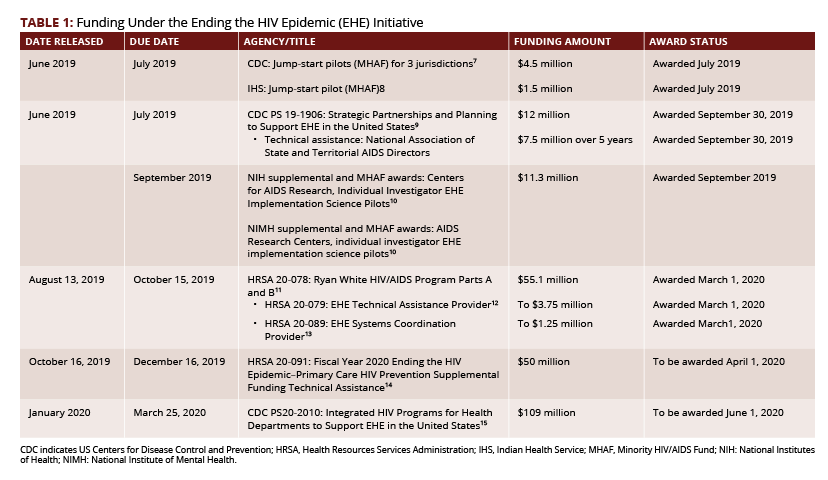
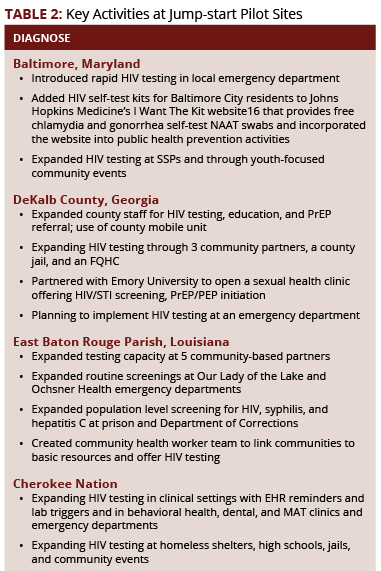
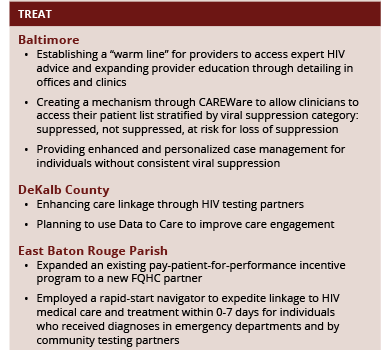
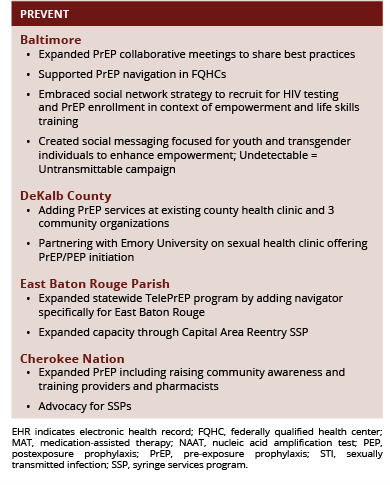
Thompson is principal investigator of the AIDS Research Consortium of Atlanta; past chair of the HIV Medicine Association; interim chair of the Fulton County HIV/AIDS Prevention, Care, and Policy Advisory Committee; and a practicing HIV physician.
References
- Branswell, H. New CDC director predicts U.S. can end AIDS epidemic within seven years. Stat News, 3-19-18. https://www.statnews.com/2018/03/29/cdc-director-hiv-remarks. Accessed February 1, 2020.
- Address Before a Joint Session of the Congress on the State of the Union. 2-5-19. https://www.govinfo.gov/content/pkg/DCPD-201900063/html/DCPD-201900063.htm. Accessed February 1, 2020.
- National HIV/AIDS Strategy for the United States: 7-10 https://obamawhitehouse.archives.gov/sites/default/files/uploads/NHAS.pdf. Accessed February 1, 2020.
- National HIV/AIDS Strategy for the United States: Updated to 2020. https://files.hiv.gov/s3fs-public/nhas-update.pdf. Accessed February 1, 2020.
- What is ‘Ending the HIV Epidemic: A Plan for America’? https://www.hiv.gov/federal-response/ending-the-hiv-epidemic/overview . Accessed February 1, 2020.
- Budget of the U.S. Government, Fiscal Year 2020. https://www.govinfo.gov/content/pkg/BUDGET-2020-BUD/pdf/BUDGET-2020-BUD.pdf. Accessed February 1, 2020.
- HHS Awards Pilot Funds to Three Jurisdictions to Jumpstart Federal Initiative to End HIV Epidemic in the U.S. 6-3-19. HIV.gov Website. https://www.hiv.gov/blog/hhs-awards-pilot-funds-three-jurisdictions-jumpstart-federal-initiative-end-hiv-epidemic-us. Accessed February 1, 2020.
- IHS and Cherokee Nation launch new HIV pilot project. Indian Health Service Website. Available at: https://www.ihs.gov/newsroom/pressreleases/2019pressreleases/ihs-and-cherokee-nation-launch-new-hiv-pilot-project/. Accessed February 1, 2020.
- CDC PS 19-1906: Strategic Partnerships and Planning to Support Ending the HIV Epidemic in the United States. Centers for Disease Control and Prevention Website. https://www.cdc.gov/hiv/pdf/funding/announcements/ps19-1906/cdc-hiv-PS19-NOFO.pdf Accessed February 1, 2020.
- CFAR/ARC Ending the HIV Epidemic Supplement Awards. National Institutes of Allergy and Infectious Diseases Website. Available at: https://www.niaid.nih.gov/research/cfar-arc-ending-hiv-epidemic-supplement-awards. Accessed February 1, 2020.
- HRSA 20-078: Ryan White HIV/AIDS Program Parts A & B. Health Resources Services Administration Website. https://www.hrsa.gov/grants/find-funding/hrsa-20-078. Accessed February 1, 2020.
- HRSA 20-079: EHE Technical Assistance Provider. Health Resources Services Administration Website. https://www.hrsa.gov/grants/find-funding/hrsa-20-079 Accessed February 1, 2020.
- HRSA 20-089: EHE Systems Coordination. Health Resources Services Administration Website. https://www.hrsa.gov/grants/find-funding/hrsa-20-089 Accessed February 1, 2020.
- HRSA 20-091: Fiscal Year (FY) 2020 Ending the HIV Epidemic - Primary Care HIV Prevention (PCHP). Health Resources Services Administration Website. https://www.hrsa.gov/grants/find-funding/hrsa-20-091 Accessed February 1, 2020.
- CDC PS20-2010: Integrated HIV Programs for Health Departments to Support EHE in the US. Centers for Disease Control and Prevention Website. https://www.cdc.gov/hiv/funding/announcements/ps20-2010/index.html Accessed February 1, 2020.
- IWTK: I Want the Kit Website. www.iwantthekit.org. Accessed February 12, 2020.
- Buchbinder S, Havlir D. Getting to Zero San Francisco: A Collective Impact Approach. J Acquir Immune Defic Syndr 2019;82:S176—S182. doi: 10.1097/QAI.0000000000002200.
- Ending the AIDS Epidemic in New York State. New York State Department of Health Website. https://www.health.ny.gov/diseases/aids/ending_the_epidemic/ . Accessed February 1, 2020.
- A Budget for America’s Future: Fiscal Year 2021. https://www.whitehouse.gov/wp-content/uploads/2020/02/budget_fy21.pdf Accessed February 12, 2020.
- Ending the Epidemic: Jurisdictional Plans. National Association of State and Territorial AIDS Directors Website. https://www.nastad.org/maps/ending-hiv-epidemic-jurisdictional-plans Accessed February 1, 2020.
